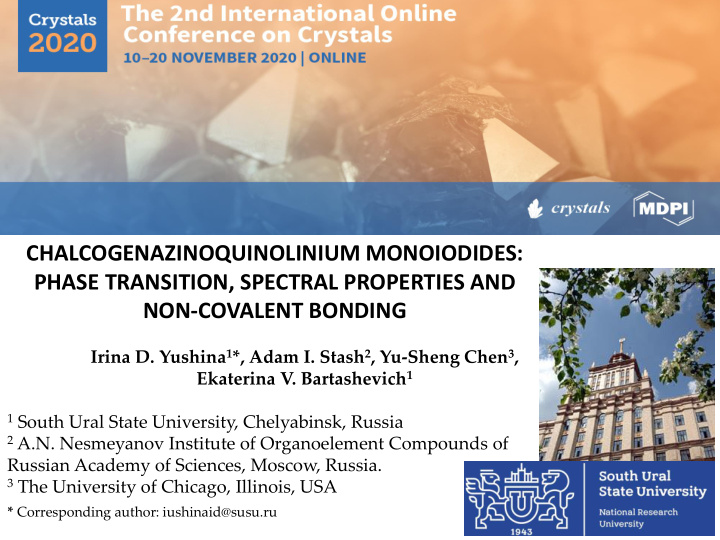



CHALCOGENAZINOQUINOLINIUM MONOIODIDES: PHASE TRANSITION, SPECTRAL PROPERTIES AND NON-COVALENT BONDING Irina D. Yushina 1 *, Adam I. Stash 2 , Yu-Sheng Chen 3 , Ekaterina V. Bartashevich 1 1 South Ural State University, Chelyabinsk, Russia 2 A.N. Nesmeyanov Institute of Organoelement Compounds of Russian Academy of Sciences, Moscow, Russia. 3 The University of Chicago, Illinois, USA * Corresponding author: iushinaid@susu.ru 1
Abstract: The study of phase transitions in organic crystals is a step to tunable modification of their physicochemical properties as a part of modern crystal engineering approaches. Organic crystals with polyiodide anions and S,N- containing heterocycles, such as substituted thiazolo(azino)quinolinium salts [1-3] open possibility for the design of nonlinear optical, semiconductor materials and components of dye-sensitized solar cell devices. The methodology of the present work includes consistent analysis of X-Ray diffraction and the results of periodic quantum-chemical calculations in order to reveal the changes in crystal packing, non-covalent interactions features and electronic properties as a result of undergoing low-temperature phase transition. Objects of the study are two newly obtained crystal structures of substituted thia- and oxazinoquinolinium iodides with the typical I … I halogen bonds. Low-temperature phase transition with decrease of symmetry from P21/c to P-1 is registered by X-Ray diffraction and Raman spectroscopy, the interpretation of the observed spectral changes is made on the basis of theoretic spectra in periodic approximation. 1. Bartashevich E.V.; Yushina I.D.; Stash A.I.; Tsirelson V.G. Crystal Growth & Design, 2014, 14 , P. 5674. 2. Yushina I.D.; Kolesov B.A.; Bartashevich E.V. New Journal of Chemistry, 2015, 39 (8), P. 6163-6170 3. Yushina I.D., Tarasova N.M., Kim D.G., Sharutin V.V., Bartashevich E.V. Crystals, 2019, 9, P. 506. Keywords: quinolinium iodides; halogen bonding; phase transition; synchrotron radiation; Raman spectroscopy 2
Results and Discussion I Synthesis & crystallization of chalcogenazinoquinolinium monoiodides OQ TQ Room temperature polymorph, P21/c Low temperature polymorph, P-1 3
Results and Discussion II 100 K 230 K Temperature dependency of cell angles in TQ iodide Diffraction peaks in reverse space of different domain types within one single crystal of TQ 4 DOS diagram of low-temperature TQ phase with non-equivalent sulfur atoms
Methods • DFT/WC1LYP/TZVP (DZVP for I) CRYSTAL17 program • Huber 3 diffractometer with a 60 ° offset angle and Pilatus3X 1M (CdTe) in temperature range from 293 (1) to 100 (1) K using an Oxford Cryojet. Conclusions • Low temperature polymorphic transition of TQ iodide was observed at 173 K with the symmetry reduction from P21/c to P-1. • Domain structure of single crystal is observed via X-ray diffraction under cooling. • Theoretic band gap estimation is 2.463 eV ( TQ ) and 2.533 ( OQ ) eV. Non-equivalence of sulfur atoms is found in low-temperature TQ phase in values of DOS projections. Acknowledgments This work was supported by the Ministry of Science and High Education of the Russian Federation, FENU 2020-0019 5
Recommend
More recommend